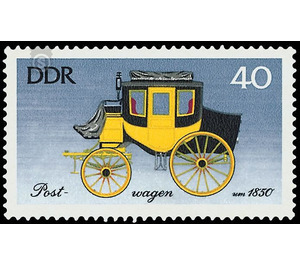Historic carriages - Germany / German Democratic Republic 1976 - 40 Pfennig
Theme: Post & Philately
| Country | Germany / German Democratic Republic |
| Issue Date | 1976 |
| Face Value | 40.00 |
| Color | grey |
| Perforation | K 14 |
| Printing Type | Rotogravure 2 |
| Stamp Type | Postage stamp |
| Item Type | Stamp |
| Chronological Issue Number | 1893 |
| Chronological Chapter | GER-DDR |
| SID | 786304 |
| In 21 Wishlists | |
Historic carriages The Ministry of Posts and Telecommunications of the German Democratic Republic issues six multicolored special postage stamps depicting historical carriages. Historic Carriages Four of the originals of the designs in this issue (10, 20, 35 and 50 Pfennig values) are in the collection of carriages of the museums in the castle of Augustusburg (Karl-Marx-Stadt district). The Kalesche on the 25-pfennig value is part of the stock of art collections in Weimar and the model of the stagecoach on the 40-pfennig value is in the collections of the postal museum of the GDR in Berlin. In the age of spaceships, airplanes and automobiles, the coach has almost completely disappeared from the horizon of today's generation as a means of transporting people and can usually only be admired as a "museum piece". While four-wheeled wagons were already known as work and load transport equipment in antiquity, the traces of the emergence of carriages can only be traced back to the 16th century. At that time, however, the use of carriages was a privilege of the high feudal nobility, and there was hardly a princely court in Europe that lacked city carriages and ceremonial carriages. However, the carriages issued in the castle Augustusburg come from a later construction period and belonged largely to the inventory of the former Royal Marstall in Dresden. After 1945 they were saved from further decay, transferred to Augustusburg and preserved and restored here with considerable state resources. The illustrated stagecoach on the 40 Pfennig value is the model of a four-seat mail coach without Langbaum in the so-called Berlin form. Carts of this kind were in use at the Deutsche Reichspost until the turn of the century. For covering two horses were provided. This, at the end of the 17th century developed in Berlin and in the aftermath constantly improved type of car was characterized particularly by its light and comfortable design with the most sparing use of wood and iron parts (15 1/2 cents without drawbar, Ortscheite and spare parts). The car body consists of an intended to accommodate four people interior space, a designated for loading the mail pieces without declared value back magazine and a mounted under the seat post front magazine in which the letter bags and packages were packaged with declared value. On the car body is provided with a leather cover, closed by Schnürketten Vache. The outer walls of the car body are covered with light metal panels, wood paneling or leather. The covers of the front and rear magazines are secured by zinc sheet and band iron.


